
If you think being a prisoner at a Tasmanian penal colony sounds bad, add coal mining to that prison sentence and you get something truly awful. Such was the case in the 1830s and 40s when, just after the famous Port Arthur Penal Colony was established, convict laborers were sent to another part of the Tasman Peninsula to work in coal mines (and you can imagine that working conditions in the mines were not a top priority). What remains of the mine-prison is now an Australian National Heritage Site. Several walking tracks explore the Coal Mines Historic Site, including a 0.8-kilometer (0.5-mile) loop through the Convict Precinct. The Convict Precinct Circuit takes about half an hour to complete, as you learn about the area’s history while exploring ruins of the barracks and prison cells.
With its pristine coastline, the Tasman Peninsula seems like a paradise today, but British colonizers saw the peninsula as a natural prison because it connects to the Forestier Peninsula via a narrow isthmus at Eaglehawk Neck that made it easy to defend against escaping convicts. Coal Mines Historic Site is located in the northwest corner of the Tasman Peninsula, where you can set out from a car park along Coal Mines Road. The wide, level track into the Convict Precinct will quickly reach the first ruins, made of stucco and wood. Walk through the ruins, following a rusty chain that has been set up along the wall as a timeline for the area’s history. A sign explains that:
Every meter of this chain stands for five years of history – as you follow it, you’ll walk through two centuries.

Here is a sample of the timeline told along the links of the chain:
- 1803 – First European settlement in Tasmania at Risdon Cove on the River Derwent
- 1830 – Establishment of the Port Arthur Penal Colony
- 1833 – Surveyors discover an outcrop of coal at this site
- 1834 – Government begins coal mining through convict labor from Pot Arthur
- 1837 – Mining expert Dr. Lhotsky surveys the mine and reports dangerous faults
- 1841 – Government introduces the probation system
- 1845 – Peak of population and production. 576 convicts, 27 military personnel, 125 civilians (including 12 women and 90 children) live at the station. 11,375 tons of coal are produced
- 1846 – Building of new solitary cells and private apartments to separate the men’s sleeping quarters.
- 1848 – Government closes the mine because of low quality coal, production inefficiency and concerns about the ‘moral state of the station.’ Mines leased to private operators Clark and McShane
- 1851 – Military guard removed from the Coal Mines Station
- 1870s onward – Mining continues under a succession of private leaseholders. The buildings fall into disrepair
- 1920s – Stone and timber from the ruins are taken to be re-used in apple sheds and farmhouses
- 1971 – 214 hectares proclaimed Coal Mines Historic Site under the National Parks and Wildlife Act.
- 1990 – Ongoing conservation programs begun by the Department of Parks, Wildlife, and Heritage
- 2007 – Coal Mines Historic Site is placed on the National Heritage List because it offers rare insight into Australia’s convict history and the use of hard labor to exploit local resources
The chain ends as you leave the ruins and continue along the wide path, exiting the forest to a grassy clearing on the coast where there are ruins of several larger buildings. Convicts were held in the punishment cells in the buildings to your left and closer to the bay are the ruins of the barracks and other settlement building.
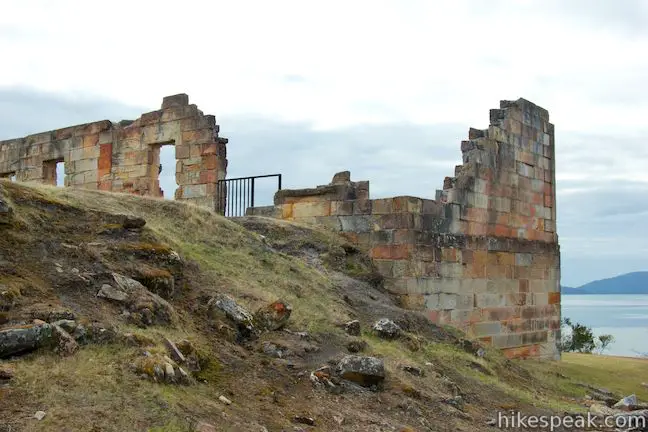
Walk down the trail along these ruins past roofless walls with square windows and crumbled corners. There are views across Norfolk Bay as the trail curves to the left along the coast around the ruins of the barracks. Step right up and walk inside the barracks. Within each door there is a hallway with four small rooms on each side.
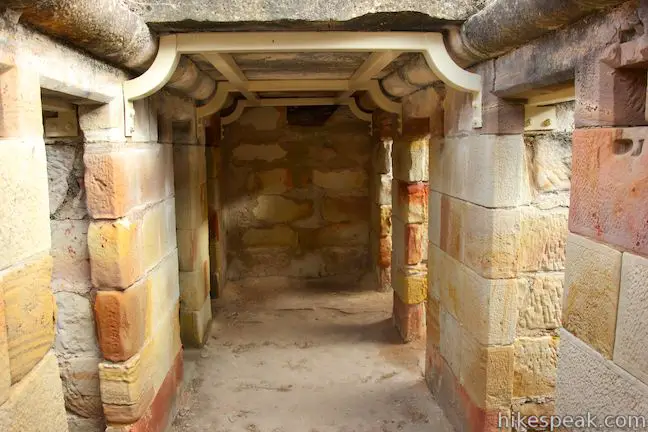
The walking trail passes the building to reach a junction. The track to the right continues along the coast to Plunkett Point, but you should take the trail to the left to explore more of the ruins in the Convict Precinct. The trail goes up a slight hill, effectively going up one story of the old buildings. The trail goes along the right side of a grassy area where there are many ruined buildings, but there’s no need to stay on the trail. You can walk out on the grass and right up to the ruins. Walk out to the wall above the ruins closest to the coast and look down on the cells of the barracks that you were just inside.
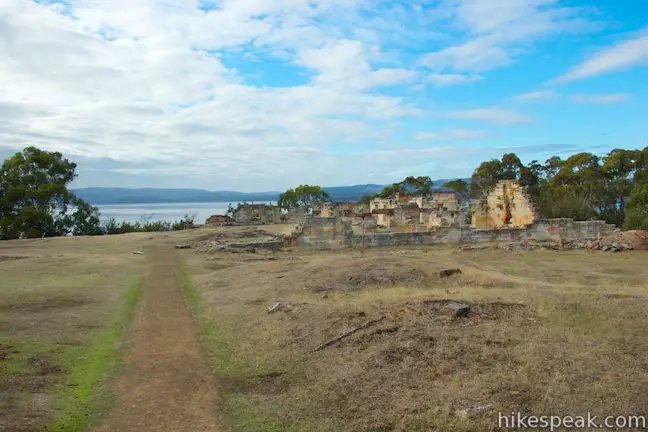
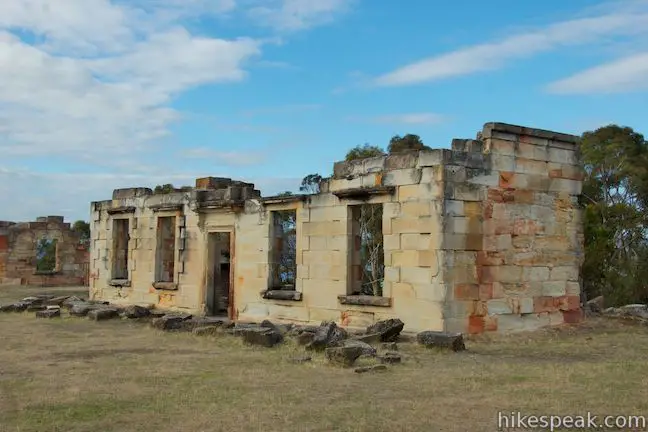
There are ruins from a few other buildings too. This area had a hospital, chapel, school, and bakery when the Saltwater River Coalfield was at its peak in the 1840s, with close to 600 convicts working here, along with 27 military personnel, wives, children, and other civilians.
Initially, only the worst prisoners from the Port Arthur Penal Settlement were sent to work in the coal mines as punishment (in 1841, convicts began going directly to the coal mines). The threat of the mines probably helped keep some of the other prisoners inline, as a sign amongst the ruins explains:
Port Arthur was no picnic, but convicts sent from there to the Coal Mines knew they were in for an even tougher time. Underground, the mining work was brutally hard and above ground, convicts labored quarrying stone, cutting timber, and hauling coal wagons. Breaches of discipline were punished with floggings and solitary confinement on a ration of bread and water.
You can see some of the solitary confinement areas as you continue up the trail toward more ruins. Tall orange posts mark the perimeter of the “separate apartments.” This two-story building had over 100 small ruins for convicts. These private sleeping cells were built in 1845 in an effort to reduce homosexual activity among the prisoner population. Concerns over what was called the ‘moral state of the station’ became one of the reasons the government shut down its penal colony.
The trail curves around the ruins of the separate apartments to reach even grimmer lodging, the solitary punishment cells. Walk down the corridor of this windowless brick building, which was built around 1843 to seem like it was below ground. You can poke your head into one of the small, dark cells and imagine the conditions. This 36-cell building was a terrible place to be held, but it was actually an upgrade from a 4-cell jail built within one of the underground mines. Convicts compared being held in an underground punishment cell to being buried alive and it was the most feared discipline a convict could receive.
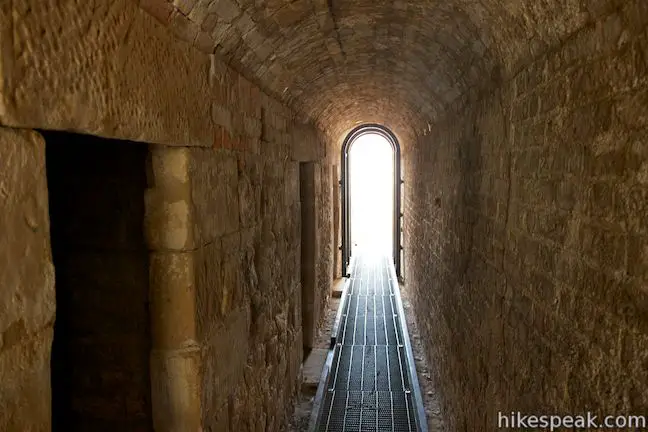
As you walk past a second row of solitary confinement cells and return to the trail, you will be quite thankful for your freedom. Walk a short way back to the car park on the lest leg of the trail to complete the circuit. There is no fee or permit required to visit Coal Mines Historic Site. Dogs and bikes are not allowed, but there are toilets at the car park for the Convict Precinct. If you are looking for a nearby place to camp after your walk, continue up the road to Lime Bay State Reserve.
Directions: Take Tasman Highway (A3), 25 kilometers east of Hobart to the town of Sorell. You will come to an intersection in the center of town where A3 makes a 90-degree turn. Take the road leaving A3 at this intersection, which is Coles Street/Arthur Highway (A9). This will be a right turn if you are coming from Hobart. Drive 60 kilometers on A9 to the Tasman Peninsula and turn right onto Nubeena Road (B37), which is just past the Tasmanian Devil Conservation Park and 9.5 kilometers past Eaglehawk Neck. Drive 9 kilometers on B37 and turn right on Saltwater River Road (C341), following signs for Saltwater River and Coal Mines Historic Site. Go 9.4 kilometers, turn right on Coal Mines Road, and drive another 2.2 kilometers to the car park at the start of the walk, which will be on the right.
Trailhead address: Coal Mines Road, Saltwater River, TAS 7186, Australia
Trailhead coordinates: -42.988141, 147.714598 (42° 59′ 17.30″S 147° 42′ 52.55″E)
You may also view a regional map of surrounding Australian trails, campgrounds, and lodging.
 | Cape Raoul This 12 to 14-kilometer hike explores the pristine coastline at the southwest end of the Tasman Peninsula, reaching a cape with daunting 200-meter tall cliffs dropping to swirling seas. |
 | Tasmans Arch & Devils Kitchen This 0.9-mile walk visits two impressive features on the coast of the Tasman Peninsula, a natural bridge and a chasm carved by the sea. |
 | Blowhole & Fossil Bay Lookout This short walk in Tasman National Park reaches a coastal vista point and a wave-carved tunnel through a rocky point that has the potential to spray up like a whale spout. |
 | Wineglass Bay and Hazards Beach Circuit This approximately 12-kilometer loop takes a rewarding route through Freycinet National Park, visiting pristine light sand beaches at Hazards Beach and the renowned Wineglass Bay. |
 | Cape Tourville This 0.6-kilometer circuit provides big views along the east coast of Freycinet Peninsula, circling 100-meter tall bluffs to reach the Cape Tourville Lighthouse. |
 | Friendly Beaches This hike explores a long, pristine beach on the east coast of Tasmania north of the Freycinet Peninsula. |
 | Apsley Waterhole & Lookout Track This 1.4-kilometer loop travels through a eucalyptus forest to a popular swimming hole on the Apsley River in Douglas-Apsley National Park. |
 | Cataract Gorge This 3.4-kilometer loop combines Zig-Zag Track, Cataract Walk, and Bridge Walk to explore Cataract Gorge Reserve, an impressive natural area just outside the center of Launceston. |
 | Liffey Falls This 2.2-kilometer walk passes the Upper Cascades on the Liffey River to reach the base of lovely Liffey Falls, one of Tasmania's finest waterfalls. |
 | Mount William This 3.6-kilometer out and back hike tops a short summit that is the high point of Mount William National Park with panoramic views over the coastline at the northeast corner of Tasmania. |
 | Octopus Tree and Circle Track This 1.1-kilometer loop in Hobart's Wellington Park reaches a unique eucalyptus tree with tentacles for roots that wrap around a boulder. |
 | Pinnacles Boardwalk & Summit Trig The 0.3-kilometer round trip walk on Pinnacles Boardwalk can easily be extended to a 0.75-kilometer walk on the top of Mount Wellington, checking out another short boardwalk and the trig station at the summit. |
 | Russell Falls & Horseshoe Falls This hike in Mount Field National Park visits one of Tasmania's most famous and beautiful waterfalls and can be extended from 1.8 to 2.65 kilometers by venturing to the top of Russell Falls and nearby Horseshoe Falls. |
 | Saint Columba Falls This 1.2-kilometer round trip hike descends into a rainforest to the base of a powerful 90-meter tall waterfall. |
 | More trails in Australia Explore other destinations in Victoria and Tasmania, Australia. |
 | Lime Bay State Reserve Campground This shaded campground is bordered by sandy beaches in a cove on a remote thumb of the Tasman Peninsula. |
 | Mayfield Beach Conservation Area Campground This beachfront campground is located on Great Oyster Bay on the east coast of Tasmania. |








































Go the extra miles...
Submit a rating of this hike to go with your comment. Contribute to the average trail rating.